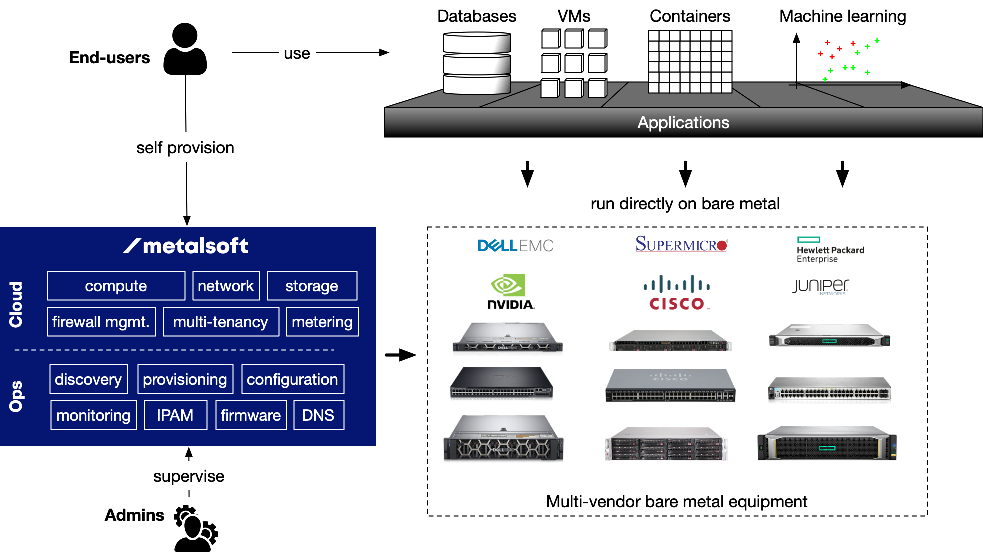Enterprises interested in great application efficiency and more consistent operations are increasingly turning to containers. In fact, 56 percent of IT leaders expect their use of containers to increase in the next 12 months. The ability to deploy applications both on-premises and in the cloud make containers an ideal solution for working within a bare-metal cloud. On the other hand, it is expected that many legacy applications will remain running on virtual machines indefinitely. To understand some of the various considerations involved in running both containers and virtual machines on the same bare-metal cloud, I talked with Bernie Wu, head of business development for MetalSoft, a company that delivers an intelligent automation software platform to manage datacenters and bare-metal equipment. Bernie has 25-plus years of experience as a senior executive at datacenter hardware and software infrastructure companies, including Conner/Seagate, Cheyenne Software, Trend Micro, FalconStor, and Levyx.
MITCH: Bernie, I can still remember when virtual machines started to replace physical servers for on-premises workloads. Then virtual machines moved to the cloud with IaaS, and the decision for organizations was whether to go public cloud, private cloud, or both—a hybrid approach. That fight seems to have settled down somewhat, but then this new thing called containers came along, and everyone got excited they would replace virtual machines. Has this happened, or are containers and virtual machines both still very much alive for cloud computing? And will they both remain so for the foreseeable future?

BERNIE: The way I see it, the primary reason for adopting containers and Kubernetes is because it abstracts cloud-level scaling problems from the developers and allows easy implementation of micro-services architectures. Hence, it is ideal for cloud-native applications. The primary reason for adopting virtual machines was to allow traditional applications to become more portable and allow the consolidation and migration of multiple application servers into fewer physical servers to increase utilization. When cloud computing became viable, these applications’ portability made it easier to migrate them to the cloud and enable an op-ex model for IT consumption. Going forward, I believe most new or refreshed applications will adopt the cloud-native container approach, but VM-based legacy applications will continue to run indefinitely.
MITCH: Is it hard to implement a solution that mixes containers and virtual machines on the same infrastructure? Some admins I’ve talked to seem to be struggling with doing this. Why is that? What kind of difficulties or challenges are involved?
BERNIE: Indeed, it can be challenging for admins who are new to Kubernetes to work with both at the same time. Virtual machines and containers are managed under different paradigms. Container images are built in a manner very similar to how you would compile an application into a single binary except that you are also packaging OS. You simply tell Kubernetes what image to use, and it goes out and pulls the image and executes it. As an admin, you don’t install anything anymore. This is an important distinction making it hard to build deployment scripts for a hybrid application because tools such as Ansible are less useful now.
Also, since containers are designed to run on a common OS, they achieve higher densities of packing applications or microservices. Therefore, they must have their own networking abstraction layer for containers.
VMs are designed to virtualize physical machines running different OSs on the same platform, and thus the networking and security are optimized around that layer of abstraction. In some cases, users will opt to run their containers on top of VMs to benefit from additional security isolation. However, this often comes with a performance penalty because of the multiple compute and networking abstraction overheads.
MITCH: Your company, MetalSoft, offers businesses a bare-metal cloud solution. What’s the advantage of this over the more traditional approach for running virtual machines and containers in an IaaS public cloud?
BERNIE: MetalSoft significantly improves the deployment, provisioning, and lifecycle management automation of a datacenter’s entire bare-metal infrastructure (servers, switches, and storage). Automation of this hardware infrastructure layer has historically been piecemeal and a messy affair with hidden costs and susceptibility to configuration drift. Because MetalSoft is designed to be hardware and application platform-agnostic, businesses and their cloud service provider partners may want to consider building their IT infrastructure on such a foundation to boost their level of automation along with their digital transformation resilience.
MetalSoft also allows this infrastructure to be managed and consumed as if using a self-service virtual private cloud. As part of this experience, MetalSoft’s workflow and provisioning templates can provide on-demand deployment of applications such as VMware and Kubernetes. This makes deploying and running applications in private or hybrid cloud on-prem or at colocation facilities more cost-effective and resilient. Finally, lightweight agents can be deployed to remotely manage infrastructure located on the edge or in unattended areas.
Users can also expect to see performance gains as a result of running on bare-metal servers and bare-metal networks. MetalSoft’s direct orchestration of TOR switches to configure tenant-isolated native L2 or L3 VLANs can reduce latencies and provide higher security and noisy-neighbor isolation. Other infrastructure may experience degradation from the over-virtualization of both server and networking layers.
MITCH: Can companies wanting a hybrid solution easily combine on-prem with bare-metal cloud?
BERNIE: MetalSoft’s bare-metal platform can scale on its own to orchestrate bare-metal clouds located on-prem, at the edge (for example, micro-datacenters), or running at a CSP as part of a hybrid or multi-cloud strategy. Using Kubernetes as a portability layer, companies can move applications across their own private and public clouds to take advantage of the best possible performance-to-cost ratio or data locality. A third-party multi-cloud or hybridization platform can be used in conjunction with MetalSoft to optimize application placement if public clouds are part of the total solution. MetalSoft also supports workflow automation and infrastructure-as-code (IaC) integration capabilities using Terraform and Ansible.
MITCH: Does a bare-metal cloud solution have any cost advantage over using cloud services like AWS or Azure?
BERNIE: Yes, MetalSoft’s bare-metal cloud not only delivers performance and resilience advantages but also provides cost advantages over public cloud services. When compared to public clouds, the average estimated Total Cost of Ownership improvement is 4X. A more detailed cost analysis is available on request from MetalSoft.
MITCH: Anything else you’d like to add?
BERNIE: Although public cloud vendors are also offering bare-metal clouds, the availability of MetalSoft’s bare-metal automation platform provides a new alternative for providing a self-service, multi-tenant option that enterprises, SaaS vendors, and cloud service providers will find to be comprehensive, performant, and cost-effective for running all applications. The MetalSoft platform has been production-proven and ISO-certified for over eight years across Europe as the bare-metal cloud offering for a sister company, BigStep.
MITCH: Thanks, Bernie, for taking the time to explain all this to us.
BERNIE: You’re welcome.




